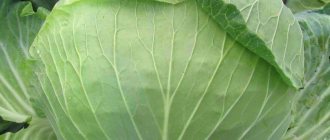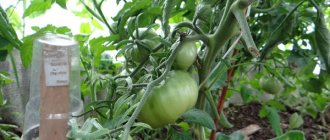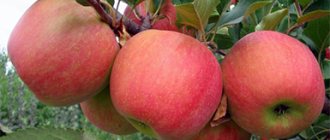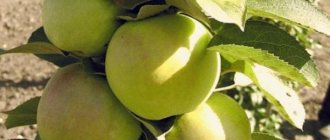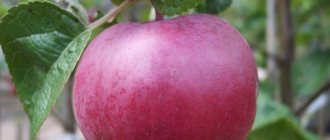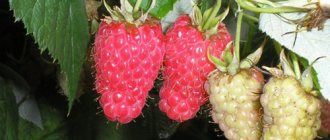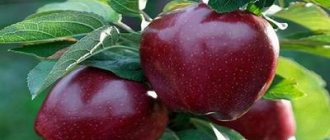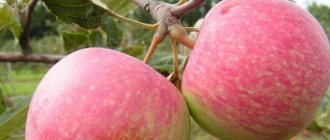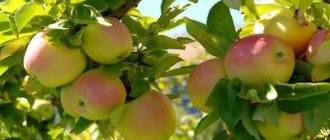Gardeners take into account many factors when choosing varieties of apple trees for a plot: the ripening time and taste of apples, the height of the tree and the rules for caring for it, the frost resistance of apple trees and various other indicators. The Uslada apple tree variety has been chosen by many summer residents for their gardens due to its excellent characteristics.
This variety has proven itself well in the central regions of Russia, as it winters well and ripens in areas with rainy summer periods.
Description of the apple tree variety Uslada
The maximum height of the tree is 3 m; timely pruning allows you to correctly form the crown and achieve the desired height. Young seedlings have a rounded crown; as it grows, it begins to stretch out and takes on the appearance of a regular oval.
The trunk and branches of the tree are dark gray in color, the buds are tightly pressed to the shoots. The leaves are ovoid, large, slightly curled downwards on the underside.
The first harvest can begin 4 years after planting the seedlings in open ground in a permanent place of growth. According to gardeners, the yield level is quite high, but to obtain it requires annual formation of the crown and proper care.
Agricultural technology and cultivation features
Watering and fertilizing
Watering is carried out from spring to the end of autumn, it should begin during the budding period and, depending on weather conditions, on average, every one and a half to two weeks for an adult tree, in a volume of 15 liters per root . For young seedlings - as the top layer of the trunk circle dries.
The seedlings are watered as the soil in the tree trunk dries out.
In the spring apple trees are fed with ammonium nitrate ; in the fall, it is necessary to apply organic fertilizers and phosphorus-potassium mineral nutrient mixtures, which will contribute to more successful resistance to frost and changes in night and day temperatures.
Advice! If the soils of your site contain an insufficient amount of basic mineral elements, in order to obtain a full harvest, you need to carry out additional fertilizing with phosphorus-potassium fertilizers, starting from the period of budding until fruit filling.
Pruning and crown formation
The most important part of caring for fruit trees is pruning . It is carried out twice a year , in the fall it is of a sanitary nature - damaged and weak shoots are removed before wintering.
Apple tree pruning diagram.
In the spring, pruning is carried out with the aim of forming the crown and removing shoots that will not bear a harvest, but by their existence are capable of drawing on the vital forces of the apple tree. Such shoots include crowns growing inwards, old branches that no longer bear fruit, diseased and outdated ones.
For video instructions on proper trimming, see below:
Important! For the Uslada variety, the formation of the crown is very important: due to the active growth of the crown, excess shoots can interfere with the normal development and ripening of fruits, so special attention should be paid to it.
Taste qualities of the Uslada apple variety
The weight of a ripe fruit varies from 100 to 200 g. Apples are round in shape, in some cases they can be oval, and there are no ribs. The peel is quite thin, but at the same time elastic. The main color is green-yellow, the top color is red-crimson. You can see small light dots under the skin.
Uslada apples have a sweet and sour taste with a raspberry aftertaste. The internal color of the ripe fruit is white, sometimes soft pink apples are found. The pulp is juicy, dense, tender, the grains are small. After the apples are ripe, they do not fall off - they remain hanging on the branches of the tree, holding tightly to the cuttings.
History of the variety
Uslada apples are the brainchild of the famous breeder S.I. Isaev, a student of Michurin himself. By crossing wild and cultivated varieties of apples, the scientist sought to take only the best features from each. And he succeeded. In 1961, the experiments were successful, and a new variety appeared. It is resistant to severe frosts, tolerates wet, rainy summers and is practically not affected by scab.
Pros and cons of the Uslada apple tree variety
According to the description, photos and reviews of planting the Uslada apple tree, it is necessary to take into account that the variety has a certain number of advantages and disadvantages. The advantages of the Uslada apple tree include:
- early fruit ripening;
- high level of productivity;
- annual fruiting;
- the versatility of the fruit – suitable for canning, long-term storage, and fresh consumption;
- excellent taste;
- attractive appearance;
- ripe fruits contain a large amount of vitamins;
- high level of resistance to low temperatures;
- The Uslada apple tree is resistant to a large number of diseases.
As practice shows, no significant deficiencies have been found in the variety; the only thing that is required is to trim the crown, as it is quite thick.
Important! If pruning is done poorly, the yield decreases and the fruits grow in different sizes.
Characteristics and description
Before planting Uslada in the garden, you need to understand the description and characteristics of the variety.
Tree dimensions
The trees of the variety are classified as low-growing, since their height rarely exceeds three meters. However, sometimes trees can grow up to 4-5 meters. Features of the plant's crown include its rounded shape, as well as a large number of side shoots.
Shoot-forming ability
People who are going to grow seedlings in their garden are interested in their tendency to form shoots. This variety, like many other plants, has dense branches. Therefore, experts recommend regularly pruning them so that the growth and ripening of the crop does not stop.
Fruiting
The fruiting of Delight has some peculiarities that need to be dealt with.
Flowering and pollinators
The flowering of the seedling begins in the second half of spring. At this time, the branches are covered with fragrant flowers, which fall off by mid-June.
The variety is classified as self-sterile apples that require additional pollinators. Bogatyr, Orlik or Grushovka varieties are used as pollinators.
Ripening time and harvest
Harvest ripening begins at the end of July and the first half of August. Therefore, it is necessary to collect ripe fruits during this period. However, sometimes you need slightly underripe apples. In this case, you will have to collect fruits in early July.
Tasting score and yield
With proper care, an adult tree can bear more than eighty kilograms of fruit. One of the advantages of Uslada is the taste of the harvest. Ripe apples are quite juicy, sweet and without sourness.
Low temperature resistance
This variety is considered a frost-resistant plant that can easily withstand winter in the middle zone. Uslada is also resistant to sudden temperature changes. However, the tree does not tolerate drought so well and therefore in the summer it is regularly watered so that the soil does not dry out.
Immunity to diseases
Uslada is a variety that is known not only for its pleasant taste, but also for its excellent disease resistance. Seedlings are immune to common fungal diseases. However, the variety is best protected from scab. Therefore, some gardeners do not carry out preventive treatment of seedlings.
Requirements for soil and climatic conditions
Uslada grows best in central regions with a temperate climate. However, the winter hardiness of the variety allows it to be grown in northern regions with low temperatures. The soil in which the tree will grow must be fertile and contain sufficient nutritional components.
Planting and caring for the autumn apple tree Uslada
To obtain a high yield, it is necessary to correctly carry out the planting and further care of the tree. It is recommended to plant apple trees in open ground in early spring or mid-September - early October. It is necessary to maintain the permissible distance between seedlings, which varies from 4 to 5 m.
During the growth process, seedlings need to be watered in a timely manner, fertilize and fertilize, form a crown, and carry out preventive work, thanks to which the appearance of pests and many diseases can be prevented. To ensure a high harvest, the tree crown is formed annually.
Selection and preparation of a landing site
A high yield from the Uslada apple tree can only be achieved if high-quality care is provided, which also includes the selection and preparation of land for planting planting material in open ground. The selected area must be well lit, since apple trees are light-loving trees and also protected from winds.
The best option for planting trees would be chernozem soils, light sandy loams and loams. This choice is due to the fact that the soils are well aerated, as a result the root system receives the required amount of oxygen. Heavy soils are quite acidic and wet, which is why trees growing on such lands are more likely to be susceptible to disease.
Attention! It is not recommended to plant the Uslada apple tree variety on soils where there is close groundwater.
Seedling preparation
Seedlings for planting should be selected carefully, paying special attention to this process. It is recommended to purchase planting material at the very moment when you plan to plant trees in open ground. If it was decided to purchase seedlings in advance, it is best to choose trees with a closed root system. It is necessary to pay attention to the trunk and shoots, they must be strong, without mechanical damage. The root system should be elastic and moist. For better survival, you can use rooting agents; for this, before planting, the roots of the tree are soaked for several hours in a special product.
Landing rules
After studying general information about the Uslada apple variety, looking at the photo and description of the variety, you need to familiarize yourself with how to properly plant a purchased seedling in open ground. The process of planting apple trees of the Uslada variety is as follows:
- Dig a hole measuring 70x50 cm (depth x width).
- The bottom of the pit is loosened.
- Then add 10 liters of fertile soil, 20 liters of humus, 5 kg of peat, 25 g of superphosphate, 15 g of nitrogen and potassium fertilizers.
- To make the seedling stable, you can pre-install a support - pegs.
- Before planting a tree in open ground, you must first pour 10 liters of water into the planting hole.
- A tree is planted on a mound of nutritious soil mixture, carefully distributing the roots.
- Cover with the remaining soil.
- Pack tightly.
- After the planting process is completed, the apple tree is watered and the soil around it is mulched.
Watering and fertilizing
The Uslada variety apple tree must be watered regularly. The frequency for a seedling is once every 7 days. The soil under the tree should always be moist and loose. If the summer turns out to be dry, then the frequency and amount of watering is increased. Weeds that appear in the root circle are removed. To retain moisture, it is best to mulch the soil.
It is recommended to use organic matter and minerals as fertilizing. Every year in early autumn per 1 sq. m need to be poured under the trees:
- Rotted cow manure – 5 kg.
- Bird droppings – 1 kg.
- Compost – 8 kg.
At the time of flowering, nutritious fertilizers are applied, mainly liquid fertilizers. A trench up to 30 cm deep is made around the trunk, into which organic matter is poured, for example, slurry or chicken droppings.
Advice! A young tree needs about 20 liters of water, an adult plant – 30 liters.
Trimming
Pruning is an equally important step in the process of growing an Uslada apple tree. When performing the procedure, you should not leave untreated stumps. Dry branches are removed so that a small amount of living tissue is captured. The cut area is cleaned with a knife and treated with garden varnish.
If you plan to thin out the crown, then you need to take into account one important feature - the branches should not touch each other, much less grow inward. After pruning, the sun's rays should penetrate the crown of the Uslada apple tree.
Important! Tree pruning work must be completed before the sap begins to flow; it is not recommended to carry out these manipulations with the apple tree in the fall.
Preparing for winter
Despite the fact that the Uslada apple tree can withstand low temperatures, many gardeners prefer to cover the trees for the winter, as a result of which the trunk can be protected from rodents and insects.
For shelter use:
- roofing felt;
- parchment;
- mesh;
- spruce and pine paws;
- roofing felt
In addition to these materials, you can use lime or naphthalene. Thanks to whitewashing, you can protect the tree trunk not only from rodents, but also from a number of pests and sunburn.
Attention! If you provide the Variety Uslada apple tree with proper care, the yield and taste of ripe fruits will be good.
Landing
Planting dates for apple trees: spring (April and early May) or autumn (October).
Choose a sunny location, away from groundwater. It is not recommended to plant trees in lowlands. The soil needs to be fertile, loose, with a neutral reaction (on poor soils we add more organic matter, on heavy soils we add sand and add drainage). Technology:
- A few weeks before planting, we dig a hole 80 cm deep and 1 m in diameter.
- Mix the top layer of soil with compost, peat chips, rotted manure; add two glasses of wood ash and 100-200 g of superphosphate.
- We install a peg in the center to which we will tie the apple tree.
- We pour the soil mixture into the hole to the top and even with a mountain, forming a mound of 15 cm.
- We make a hole and place the seedling, carefully straightening the roots.
- We fill it with substrate, leaving the root collar above the ground level (3-5 cm).
- We compact it and tie it to the support.
- We build an earthen roller around the perimeter of the tree trunk circle.
- Water the tree with three buckets of water.
- Mulch (sawdust, dry leaves, peat chips, wood chips, bark).
The ripening period of the Uslada apple tree
The flowering process of the Uslada apple tree occurs at the end of spring - beginning of summer. Bright, delicate and fragrant flowers completely cover the fruit tree in early June.
The fruiting phase begins after the tree reaches five years of age. Compared with other varieties, the harvest comes quite quickly.
In mid-summer you can eat the first apples; at this time the taste of the fruit is sour. A sufficient amount of sugar accumulates at the end of summer, it is during this period that the ripening process is completed. At the beginning of September they begin to harvest the finished crop.
Harvesting
The Uslada apple variety is an autumn variety. But you can start harvesting from the end of August or the beginning of September. As a rule, Uslada cuttings hold fruit well, so you don’t have to worry about the apples falling off. Ripe apples store well, but it is advisable to eat them within a month.
If you pick the fruit a little unripe, the apples can last until mid-winter. True, subject to storage conditions:
- It is advisable to place apples in well-ventilated containers;
- It is better to store boxes in a dark room, at an air temperature from +2˚ C to +5˚ C.
Careful care and timely thinning of the crown help increase the yield of the Uslada variety. And then from one mature tree you can collect approximately 80 kg of apples.
Diseases and pests
If we take into account the description and reviews of gardeners who have already been lucky enough to grow Uslada apple trees on their plots, we can say that this variety is resistant to pests and a number of diseases. Timely treatment with drugs is the best disease prevention.
In early spring, when the buds on the trees are still closed, Bordeaux mixture can be used. The crown and trunk are sprayed with a solution containing lime and copper sulfate. After bud break, insecticides are used for treatment.
Advice! As additional protection against diseases and pests, it is recommended to promptly remove fallen leaves, weeds and debris around apple trees, and dig up the tree trunk circle.
Varieties of cultivation
Columnar.
- There is no such variety of this variety.
- General characteristics of apple trees of this species.
- Such apple trees require constant care. It all starts with planting, which requires the formation of a root system, and ends with regular pruning.
- This type helps gardeners if there is not enough free space on their site.
Dwarf rootstock.
- You can grow the variety on a dwarf rootstock if you need to accelerate the onset of fruiting, as well as to increase resistance to frost and immunity to scab.
- This type is cultivated in areas with harsh climatic conditions and low temperatures in winter.
Clonal rootstock.
Clonal rootstock can stably inherit genetics, which is different from seed rootstock. This is very important if it is necessary to grow apple trees with certain properties.
Reviews about the Uslada Isaeva apple tree
Elizaveta Barinova, 50 years old, Moscow
I have been growing Uslada apple trees on my plot for 6 years now. Unfortunately, the yield level is not what we would like, but the ripe fruits are always large, since the trees grow on black soil. The height of the tree is small, the crown is oval. The variety is unpretentious in care; preventive measures using insecticides are sufficient and there are no diseases or pests.
Svyatoslav Trubin, 48 years old, Novosibirsk
When growing Uslada apple trees, the most difficult thing is the pruning process, but if you get used to it, there will be no problems. I noticed that the variety adapts quite easily to any climatic conditions, the survival rate is excellent. Uslada has been growing on my site for more than 10 years. During the first pruning, I gave the crown an oval shape and maintain it in the same shape every year. I like the taste of apples: sweet and sour, with a raspberry aftertaste.
Reviews
Anna. Stavropol. Excellent variety! It bears fruit very abundantly and every year, it shows itself well in terms of care, no special problems arise, it adapts to everything. Apples are beautiful and delicious! Stored well. I recommend it to everyone, especially beginner gardeners who do not have much experience in growing apple trees.
Sergey. Ekaterinburg. I don’t do any gardening at all, my parents do more. Here they have such an apple tree growing. Delicious apples! I even eat them in the summer, before they are ripe, they are so sour, but just like in childhood! And when we bake charlotte from them, the aroma fills the whole house!
Ekaterina Sergeevna. Omsk Three years ago, a one-year-old seedling was planted. It took root without any problems, grows and does not cause any trouble. We are expecting the first harvest in a couple of years, although, looking at this baby, I think there will be no problems at all - I chose a good place, God forbid the weather will let us down - let's feast! As soon as I pick the first apple, I’ll definitely post pictures!
Care
Necessary measures for caring for an apple tree:
Watering
A young apple tree is watered several times a month.
2-3 buckets of water are poured under the tree. An adult tree is watered less often, but the number of buckets of water is increased, adding a bucket for each year of life. To ensure uniform absorption of moisture, it is better to divide watering into two times - morning and evening. During the season, the apple tree should be watered at least 3 times:
- when the kidneys fill up;
- 2 weeks after the end of flowering;
- 2 weeks before harvest.
Tree trunk circle
It is imperative to weed the tree trunk and loosen the soil - this will facilitate the delivery of oxygen to the roots and get rid of weeds. The number of loosening should be at least 5 times per season.
Mulching this area will help retain moisture and provide additional nutrition. Humus, sawdust, and dry grass are suitable as mulch.
Top dressing
In spring and the first half of summer, nitrogen fertilizers are added to the soil under the tree . In the fall, during the digging period - organic and phosphate-potassium mixtures. If the pit was prepared correctly when planting the seedling, then the first application of fertilizers can begin in the 2nd year after planting. Nutrients are added to the soil in the area around the tree trunk.
In addition to fertilizing the soil, foliar feeding should also be done. To prevent the fruits from being small, the tree is sprayed with a zinc solution. This should be done carefully so as not to burn the leaves.
Trimming
Crown formation should begin in the first planting spring:
- An annual seedling is cut to a height of 80 cm (50 cm is the height of the trunk, 30 cm is the zone of formation of the skeletal layer).
- It is also necessary to form a trunk at a height of 50 cm for a two-year-old seedling, removing all shoots, leaving 3 main branches, two of which should be located at a distance of 15 cm and grow in one direction, and the third in the opposite direction. A central conductor is outlined, which should be 15-20 cm higher than the branches of the first tier, the remaining shoots are completely cut off.
- In the third year of life, the apple tree forms a 2nd tier, which should consist of two branches growing 50 cm above the first. The branches of the second row and the central conductor are shortened. The remaining branches are removed.
- A year later, the entire procedure is repeated, after which the formation of the crown is considered complete.
Advantages and disadvantages
The main advantages of this variety include:
- resistance to winter cold;
- immunity to diseases;
- immunity to dampness;
- generous and stable harvests;
- excellent taste of fresh fruits (they also make delicious jams, compotes, juices and baking fillings);
- easy care;
- An excellent variety for the central regions, but can grow almost everywhere.
This apple tree has no particular disadvantages. But it requires regular pruning. This is painstaking work that is difficult for a novice gardener to complete. But with experience, pruning will become less of a burdensome process.
Ripening and fruiting
- Flowering begins in the last days of spring, the tree is completely covered with rich, delicate flowers with a pleasant aroma by the 2nd week of June.
- The variety begins to bear fruit in the fourth or fifth year, which is quite fast when compared with other varieties that produce large fruits.
- The fruit can be eaten from the middle of the summer season if you like the sourness in it. But apples gain more sugar content towards the last days of summer, at which time they ripen. The harvest is harvested in September.
- Fruits can be stored until the last days of January, and if they are picked early, until the last days of winter.
Regions suitable for cultivation
The variety was sent for state long-term testing in 1977. Uslada was officially registered in the State Register in 1996. Apple tree recommended for growing :
- in the Central regions of the Russian Federation,
- Moscow region,
- in the Northwestern regions.
Uslada tolerates moderate frosts well, as well as rainy climates, due to its high resistance to scab.
Uslada is successfully grown in the Leningrad region. Despite the short summer and large amounts of seasonal rainfall, the apple tree produces good harvests.
When using a dwarf frost-resistant rootstock, the Uslada Apple tree can adapt perfectly and produce abundant harvests in Siberia.
